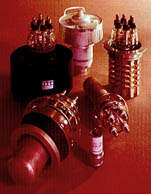Copper Enhances Communications
 Some of the many tubes from Richardson Electronics. All depend on some form of copper and its alloys.
Some of the many tubes from Richardson Electronics. All depend on some form of copper and its alloys.Copper and its alloys have played a critical role in electronics since the first electron tubes were created early in this century. In spite of the inevitable dominance of semiconductors, some $2 billion worth of tubes are still manufactured worldwide yearly, according to Edward J. Richardson, CEO of Richardson Electronics, Ltd., LaFox, Illinois, a major manufacturer and distributor of tubes.
Tubes still perform uniquely or better than semiconductors in several applications:
- Induction-heating and microwave ovens are still mostly powered by magnetrons made using copper alloys.
- Rectifier tubes made with copper alloys survive overloads better than semiconductor rectifiers.
- Most large TVs and desktop computer monitors still depend on cathode ray tube (CRT) displays, which use copper alloys in their electron guns and screen masks. Portable TVs and computers use various solid-state displays.
- Broadcasting, where some tubes are the size of jeroboams of champagne. Very-high and ultra high frequency communications still depend on tubes made of copper and its alloys.
- Since radar was invented in the late 1930's, it has been powered by klystrons and magnetrons largely made of copper alloys. Varian Associates, one of the major sources for such tubes, recently sold its tube business to Communications & Power Industries (CPI), also in Palo Alto, California.
- The VHF and UHF signals generated by the tubes are conducted to the antennas that broadcast them by hollow conduits called wave-guides and by couplers - both of which are often made of copper and its alloys.
"At high frequencies, copper is 30% to 40% more efficient than aluminum in wave-guides." That's according to G. Scott Ackland, manager of engineering services for Antek in Frederick, Maryland. Its wave-guides conduct the UHF frequency signals inside satellite earth stations. "We rarely use any material other than oxygen-free, high-conductivity (OFHC) copper. Sometimes we fabricated with bronze because that's what the military specifies," says Ackland. Besides its higher Antek because it's easier to fabricate. Kevlin Microwave Corporation also uses OFHC copper for the central conductor in radars, according to John Rice, sales manager for the Wilmington, Massachusetts-based manufacturer. The coupler is the component that conduits the signal from the fixed wave-guide to the rotating board or ground-based radar.
The vast majority of electron tubes are now made outside the U.S., mostly in the Far East. The inexpensive magnetrons that power microwave ovens are all made in South Korea, which is also a major source for CRTs used in TVs and desktop PCs.
Antek: 301/663-5443
CPI: 415/846-3643
Kevlin Microwave: 800/562-2811
Richardson Electronics: 800/323/1770
Also in this Issue:
- High Strength Copper Alloys Boost Injection Molding
- Bronzes: Copper Alloys that Counter Friction
- Copper Enhances Communications
- Copper Ensures More Hot Water
- Fashionable Facilities Count on Copper Cachet
